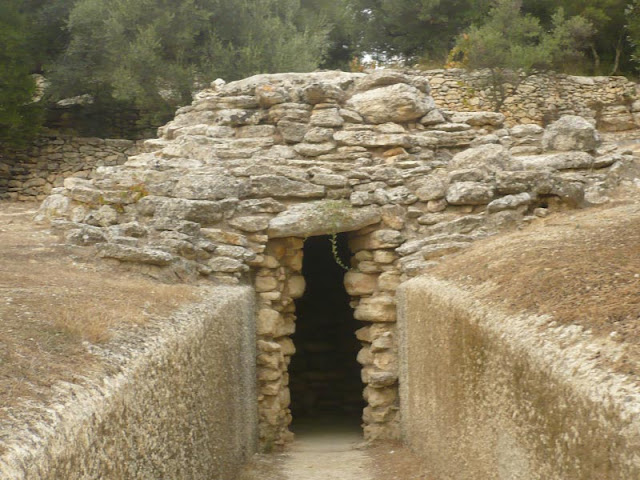Crete, the largest island in Greece, is a land steeped in history and myth. It has been home to some of the most advanced ancient civilizations, including the Minoans, whose sophisticated culture left a significant mark on the island. Among the most fascinating remnants of this illustrious past are the ancient tombs scattered across the island. Exploring these tombs offers a unique glimpse into the beliefs, customs, and daily lives of the people who once inhabited Crete.
The Minoan Civilization and Burial Practices
The Minoans, who flourished from approximately 3000 to 1450 BCE, are perhaps the most famous ancient inhabitants of Crete. Their burial practices were elaborate and varied, reflecting their complex society and religious beliefs. Minoan tombs can be categorized into several types, including tholos (beehive) tombs, chamber tombs, and pit graves.
Tholos Tombs
Tholos tombs, or beehive tombs, are among the most impressive and best-preserved types of Minoan tombs. These circular, dome-shaped structures were often built into hillsides and used for communal burials.
- The Tholos Tomb of Kamilari: Located near the ancient site of Phaistos, this tholos tomb dates back to the Middle Minoan period. It consists of a large circular chamber with a corbelled roof, constructed using large limestone blocks. The tomb was used for multiple burials over several generations, and excavations have revealed a wealth of grave goods, including pottery, bronze tools, and figurines.
- The Tholos Tombs of Platanos: Situated near the village of Platanos, these tombs are another excellent example of Minoan tholos architecture. They demonstrate the sophisticated construction techniques of the Minoans and their emphasis on communal and familial burial practices.
Chamber Tombs and Pit Graves
In addition to tholos tombs, the Minoans also used chamber tombs and pit graves for burials. Chamber tombs were typically cut into rock and featured multiple burial chambers, while pit graves were simpler, consisting of a rectangular pit lined with stones.
- The Chamber Tombs of Armeni: Near the town of Rethymno, the necropolis of Armeni features an extensive collection of chamber tombs dating from the Late Minoan period. These tombs are notable for their well-preserved architecture and the rich array of artifacts found within them, including pottery, weapons, and jewelry.
- Pit Graves of Mochlos: The site of Mochlos, on the northeastern coast of Crete, has yielded numerous pit graves from the Early Minoan period. These graves provide valuable insights into the early development of Minoan burial practices and the socio-economic status of the individuals buried there.
Mycenaean and Post-Minoan Tombs
After the decline of the Minoan civilization, Crete came under the influence of the Mycenaeans from mainland Greece. This period saw the continuation and adaptation of earlier burial practices, with the construction of new types of tombs and the reuse of existing ones.
- The Tomb of Minos: Located near Knossos, this large tholos tomb is believed to have been constructed during the Mycenaean period. It reflects the fusion of Minoan and Mycenaean architectural styles and provides evidence of the cultural exchange between the two civilizations.
- The Warrior Graves of Archanes: Excavations at Archanes, near Heraklion, have uncovered a series of warrior graves from the Late Minoan and early Mycenaean periods. These graves contain rich burial offerings, including weapons, armor, and gold jewelry, indicating the high status of the individuals buried there.
Cultural and Religious Significance
The ancient tombs of Crete offer valuable insights into the cultural and religious beliefs of the island’s early inhabitants. The elaborate burial practices and grave goods suggest a belief in an afterlife, where the deceased would require provisions and personal items. The inclusion of weapons, tools, and luxury items in burials reflects the social hierarchy and the importance of status in Minoan and Mycenaean societies.
- Rituals and Offerings: Archaeological evidence indicates that the tombs were sites of ongoing rituals and offerings. Libations, food offerings, and the placement of symbolic objects were common practices, underscoring the continued reverence for the deceased and the tombs as sacred spaces.
- Symbolism and Art: The decorations and artifacts found in the tombs are rich in symbolism. Figurines, frescoes, and carved motifs often depict religious scenes, deities, and symbols of power and protection, providing a window into the spiritual world of the ancient Cretans.
Visiting Cretan Tombs Today
Exploring the ancient tombs of Crete is a fascinating experience that allows visitors to connect with the island’s distant past. Many of these tombs are accessible to the public and are often located in picturesque settings that enhance their historical allure.
- Guided Tours and Museums: Several sites offer guided tours that provide in-depth information about the tombs and the civilizations that built them. Museums such as the Heraklion Archaeological Museum and the Archaeological Museum of Chania house many of the artifacts discovered in these tombs, offering further context and understanding.
- Respect and Preservation: When visiting these ancient sites, it is important to respect their historical and cultural significance. Preserving these sites ensures that future generations can also experience and learn from Crete’s rich archaeological heritage.
Conclusion
The ancient tombs of Crete are not just remnants of a bygone era; they are enduring testaments to the island’s rich and complex history. Exploring these tombs offers a unique opportunity to delve into the lives, beliefs, and practices of the Minoans and their successors. As we uncover the secrets of these ancient burial sites, we gain a deeper appreciation for the cultural heritage that continues to shape the identity of Crete today. Whether you are a history enthusiast, an archaeology buff, or simply a curious traveler, the ancient tombs of Crete promise a journey of discovery and wonder.


